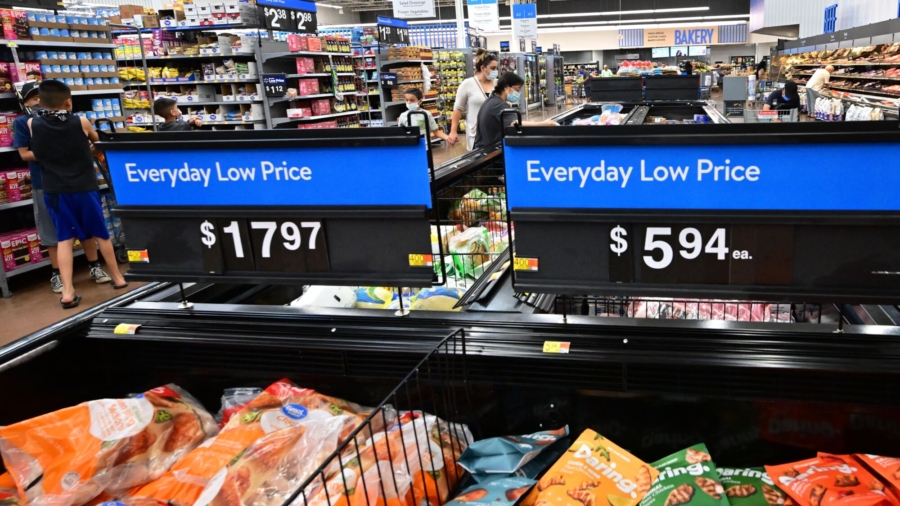Although U.S. employers added far more jobs in June than analysts expected and the unemployment rate remained at 3.6 percent, some experts say that a closer look at the data reveals that the metrics the Fed looks at to gauge whether inflation is slowing down have all deteriorated.
The closely-watched non-farm payrolls report, released on July 8 by the Bureau of Labor Statistics (BLS), showed that the U.S. economy added 372,000 jobs last month, well above the market estimate of 250,000.
The jobs report also showed the unemployment rate holding steady at 3.6 percent while U-6, a broader measure of unemployment that includes people out of the workforce who are ready to take a job, fell to 6.7 percent, a record low.
Inflation Slowdown?
But metrics in the jobs report that the Federal Reserve tracks to gauge inflationary pressures in the economy all deteriorated, according to Alfonso Peccatiello, former portfolio manager for ING Deutschland and now author of the Macro Compass.
“All the metrics the Fed is looking at for signs of an inflation slowdown actually worsened,” Peccatiello said in a series of posts on Twitter.
Evidence of a scarcer supply of labor is one such metric, as this puts upward pressure on wages and makes it harder for the Fed to hit its inflation target of around 2 percent.
The labor force shrank by 350,000 people, the report showed, meaning that the number of people in the United States looking for a job became smaller.
“The ‘great resignation’ people aren’t coming back,” Peccatiello stated.
Another metric is wage growth, which the report showed came in at a robust 0.3 percent month-over-month and 5.1 percent year-over-year in June. While a slight decline from May, the figures suggest persistent upwards wage pressures, which feed into inflation more broadly.
Further, the average workweek hours inched down and both the labor force participation rate and the employment-population ratio edged down, reinforcing the view of a labor supply scarcity.
“Summarizing, this labor market report was solid although looking under the hood less than one could imagine by reading headlines only,” Peccatiello said, adding that, “what’s more important is that all metrics the Fed is looking at for hints of an inflation slowdown actually worsened.”
Signals of stubbornly persistent inflation mean the Fed is more likely to keep hiking rates aggressively to reduce demand in the economy and tame soaring prices. That, in turn, raises the likelihood that the economy might tip into a recession.
“The more the Fed does now, the more long-term damage the economy will need to handle,” Peccatiello said.
Recession Imminent?
Mark Hamrick, a senior economic analyst at Bankrate, told The Epoch Times in an emailed statement that, overall, the BLS non-farm payrolls report was stronger than expected and serves “as an antidote to fears about a lack of economic momentum.”
“Those fearing a recession don’t find supporting evidence for one that’s imminent in this data,” Hamrick added.
Still, even though a recession may not be imminent, Hamrick said in an interview with The Epoch Times’ sister media NTD that soaring inflation has hurt American households in ways much like a recession.
“The question of a recession may in some ways be irrelevant when they’re experiencing historic and sustained inflation, because the impacts of inflation can be every bit as damaging as that which we get during a recession,” he said.
Inflation has been running at a 40-year high in the United States, with the most recent Consumer Price Index (CPI) data showing prices rising at 8.6 percent in annual terms.
Alternate measures of inflation, however, put this figure much higher. Economist John Williams, who calculates a version of the CPI using the same methodology the government used before 1980, puts the latest figure at 16.8 percent, a 75-year high.
Hamrick told The Epoch Times that, in his view, “the employment report does nothing to dissuade Federal Reserve officials from sticking to their interest rate raising plans, looking to send inflation down, and closer to their 2 percent target.”
Fed officials are now looking to the next key inflationary signpost, namely the CPI data scheduled for release on July 13, to inform decisions on the pace and extent of future rate hikes.
Investors have, since the jobs report was released, raised their bets that the Fed will move ahead with more aggressive tightening.
A day prior to the release of the report, Federal Funds futures contracts put the odds of a 75 basis point increase at 98.7 percent, with a 1.3 percent chance of a smaller 50 basis point hike.
Currently, the CME FedWatch Tool is showing zero bets on a half-point hike, with a 92.4 percent chance for a 75 basis point increase and a 7.6 percent chance for an even bigger full percentage point hike.
From The Epoch Times


